The Myth: Do Turtles Eat Snakes? Or Do Snakes Eat Turtles?
In the animal kingdom, the relationships between species can be complex and intriguing. Some creatures are natural predators, while others are harmless herbivores; however, the question of who eats whom can be puzzling. So, do turtles eat snakes? Or do snakes eat turtles?
Yes, turtles and snakes can eat each other. Both scenarios are possible depending on the species of turtle and snake, as well as their respective sizes, habitat, and food availability. Some turtles, like common snapping turtles, eat small snakes in their habitat, whereas snakes like the Common garter and Diamondback water snake may devour smaller turtles and their eggs. However, this is not very common, as they have different diets and living areas.
That’s just the tip of the iceberg. We’ll discuss both questions in detail to understand what species of turtle eat snakes and which type of snake eat turtles. And a lot more related questions will be answered in this blog. Let’s get going.
Want to know more about turtles:
Turtle’s Usual Diet
Turtles eat different foods depending on their species and habitat. But most of the turtle species are either herbivorous or omnivorous. Herbivorous turtles eat plants, algae, fruits, and flowers, while omnivorous turtles eat insects, worms, snails, fish, and carrion.

And some turtles are carnivorous that eat jellyfish, squid, shrimp, crabs, and mollusks.
If we look at their diet based on their common categories, here is what we can find:
- Most land turtles are herbivorous, meaning they eat plants, such as grass, leaves, fruits, flowers, etc.
- Sea turtles are usually omnivorous. They eat both plants and animals, such as seagrasses, algae, sponges, squid, shrimp, jellyfish, etc.
- In general, most freshwater turtles are also omnivorous, meaning they eat both plants and animals, such as worms, snails, insects, crustaceans, water plants, algae, fruit, etc.
Do Turtles Eat Snakes?
We know that turtles are opportunistic feeders and can consume a variety of prey items, including insects, fish, amphibians, plants, and small vertebrates like snakes.

And as mentioned, yes, some species of turtles do eat snakes, especially if they are part of their habitat. However, this is not a common scenario; turtles usually don’t eat snakes as their regular diet. Also, it will depend on the turtle species and the size and type of snake.
For instance, certain aquatic turtles, such as snapping turtles and softshell turtles, can eat snakes in the wild. Snakes might become a part of their diet if they encounter them in their habitat and are able to catch and consume them.
What Types of Turtles Eat Snakes?
Although it’s not very frequent, certain turtle species have been seen eating snakes in the wild. So, you may wonder, do any turtles eat snakes?
No, not all turtles eat snakes. First of all, this is not a common diet for turtles. And second, not all turtles are capable of catching snakes. Only a few can perform this if only they get the opportunity. Some examples follow.
Snapping Turtles
Snappers are the most common type of turtles that eat snakes, both on land and in water. They are aggressive and have powerful jaws. Although snapping turtles primarily eat plants, insects, fish, and amphibians, they are opportunistic feeders and may consume snakes that venture into their territory.

So, if you ask, will snapping turtles eat snakes? Yes, they will. Snapping turtles will eat snakes if they have the opportunity. Snakes are among the prey items that snapping turtles can hunt and consume with their powerful jaws and sharp beaks. However, snappers do not eat snakes very often, as they are not easy to catch and may fight back.
Softshell Turtle
The softshell is a kind of turtle that feeds mostly on fish and insects but has also been known to eat snakes. Their shells are flat and pancake-like, making them more hydrodynamic. They are mainly freshwater turtles that belong to the family Trionychidae and have 25 species in total.
Alligator Snapping Turtles
This is one of the largest freshwater turtles and is mainly found in the southeastern United States. They have a powerful bite and are capable of consuming different types of prey, including fish, aquatic plants, and even small vertebrates like snakes.
Common Snapping Turtle
This freshwater turtle species is well-known for its eclectic diet, which includes snakes, fish, insects, small animals, and even other turtles. They can kill bigger animals because of their robust jaw, which resembles a beak and allows them to administer a forceful bite.
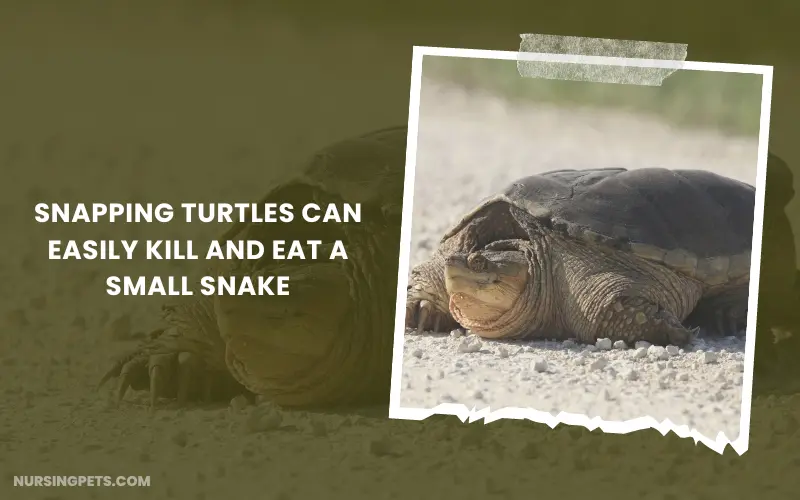
The common snapping turtles are also one of the world’s heaviest and largest freshwater turtles.
Overall, only softshell and snapping turtles species are known to eat snakes. But it is unusual for them to make snakes a primary component of their diet.
What Type of Snakes Do Turtles Eat
Although turtles usually don’t eat snakes, the type of snakes that turtles eat may vary depending on the size and species of both the turtle and the snake. Some examples of snakes that turtles may eat are garter snakes and water snakes.
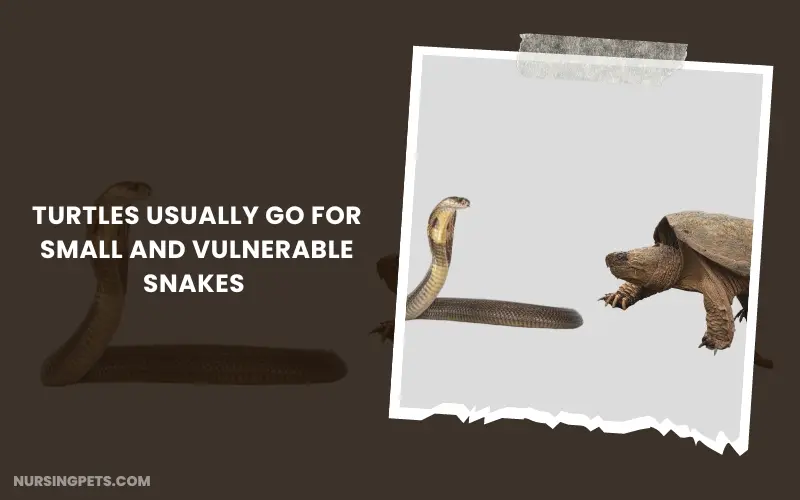
Now, if you ask, do turtles eat rattlesnakes? Well, turtles can eat rattlesnakes, but it is not a common food for them. Rattlesnakes are venomous snakes that can pose a risk to turtles, especially if they bite them in a vital area.
If we want to classify or give you a clear idea of what type of snakes turtles usually eat, the below part will give you a good idea. Turtles prefer:
Small Snakes: They are more likely to consume smaller snake species that are similar in size to the prey items turtles typically eat, such as insects, fish, and small amphibians.
Aquatic Snakes: Turtles that inhabit aquatic environments might consume aquatic snake species. These snakes often share similar habitats as turtles.
Non-venomous Snakes: Usually, turtles that feed on snakes target non-venomous species. As we mentioned, venomous snakes could pose a threat to turtles, so it’s unlikely that turtles would actively seek out or consume venomous ones.
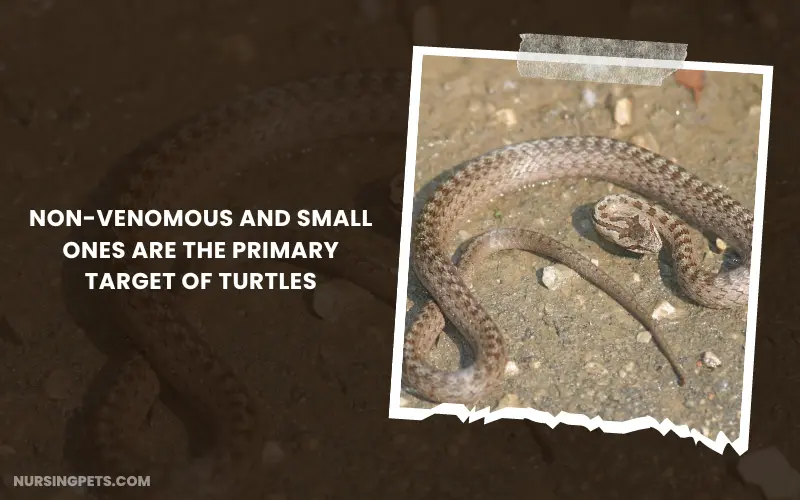
However, they can eat venomous snakes too, but that is not common. But some turtles, such as tiger snapping turtles, may be able to resist the venom and eat the snake. So, turtles normally go for non-venomous species.
Juvenile Snakes: Young turtles might consume juvenile snakes that are relatively small in size. As the turtles grow, they might not be able to capture and consume larger snake species.
Other than these, turtles can try to bite other snakes, too, if got the opportunity and believe they can beat them.
Why Do Turtles Eat Snakes?
Turtles, like many other animals, have evolved to eat a variety of foods based on their habitat, available resources, and nutritional needs. While turtles are not specialized snake predators, they may eat snakes opportunistically when small snakes cross their path.
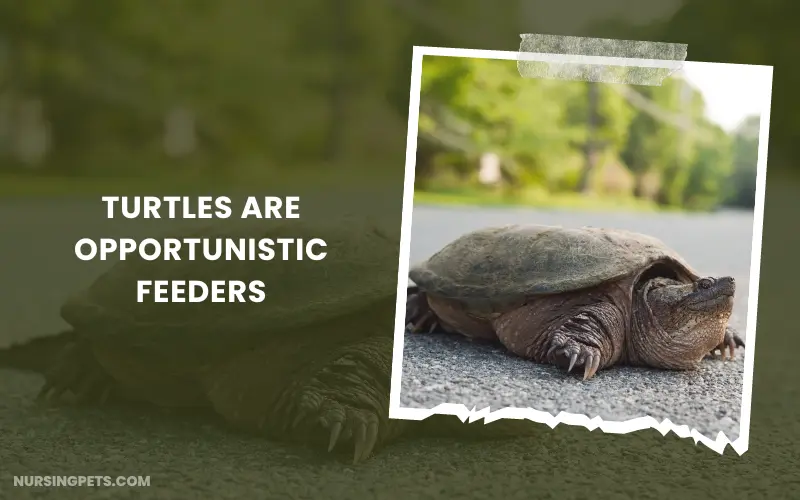
They have a diverse diet that can include various animal prey in their habitat, especially in aquatic environments where both reptiles coexist, but this behavior is not a primary or common dietary preference.
While eating a snake is not typical for turtles, it might happen if the turtle mistakes the snake for another form of food or if the snake is tiny and defenseless. Turtles are opportunistic feeders, so they may take that chance.
Do Freshwater Turtles Eat Snakes?
Yes, some freshwater turtles can eat snakes, such as snapping turtles. However, not all freshwater turtles are carnivorous, and some may prefer a more plant-based diet.
Freshwater turtles also eat worms, snails, insects, water plants, algae, fallen fruit, and occasionally other small animals.
Do Sea Turtles Eat Snakes?
No, sea turtles do not eat snakes. As aquatic reptiles, sea turtles get much of their nutrition from marine plants like seagrass and seaweed, as well as crustaceans, mollusks, jellies, fish, etc.
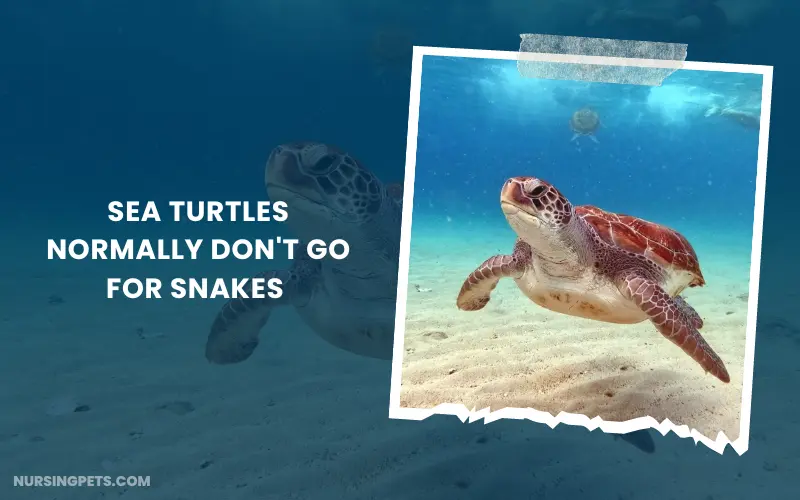
While sea turtles could run upon a snake now and again, it is not a common part of their diet.
Can Turtles Be Harmed By Eating Snakes?
Yes, eating snakes can be harmful to turtles, particularly if the snake is poisonous or larger than what the turtle can safely eat. The turtle can suffer bad health consequences or die if it eats a poisonous snake and the venom remains active.
Moreover, if the turtle decides to consume a snake that’s larger than its capacity, it might encounter difficulties such as choking or facing digestive complications.
And as we said, turtles can eat snakes as of their opportunistic feeding behavior, but it can have negative effects on turtles depending on the species and size of the snake.
However, usually, because of the turtle’s well-developed ability to digest a wide range of foods, including other reptiles, turtles may not suffer any ill effects.
What Do Snakes Eat?
Snakes are carnivorous (meat-eaters) reptiles. Depending on their species, size, environment, and availability of foods, they can eat a variety of animals. Their usual diet includes- insects, rodents, fish, amphibians, reptiles, birds and eggs.

However, certain snake species are specialist feeders and may prefer to eat a particular kind of food like eggs, whereas others are more generalist feeders and will ingest a variety of creatures.
And some snakes even prey on members of their own species. They normally swallow their food whole and digest them slowly.
Do or Can Snakes Eat Turtles?
As covered, some snakes can eat turtles, but it is not very common. Snakes that eat turtles are usually water snakes or large constrictors such as pythons and anacondas.
They mostly prey on small turtles, baby turtles and turtle eggs, as adult turtles have hard shells and can be too big for them to swallow.
Although it is possible that certain snake species may sometimes consume turtles, most turtles are much too large to be eaten by a snake.
What Snakes Eat Turtles?
Even among the few snake species that have been documented as eating turtles, it is not normal practice for most snakes to actively seek turtles. Here are just a few examples of snakes that have been seen devouring turtles:

- Black Swamp Snake
- Cottonmouth
- Water Snakes
- Eastern Diamondback Rattlesnake
- Gaboon Viper
- Green Anaconda
- King Cobra
- Pit Vipers
- Reticulated Python
- Common Kingsnake
- Corn Snakes
- Common Garter
There may be other snake species that can eat turtles, but these are some of the common ones that have been reported.
Why Do Snakes Eat Turtles?
Snakes eat turtles primarily for sustenance and due to their environmental adaptations. When turtles are available in their habitat, snakes consider them as a food source rich in nutrients like protein and fats.
Some snake species have evolved to handle turtles by having flexible jaws and the ability to stretch their bodies. This predator-prey relationship maintains ecosystem balance by controlling turtle populations and sustaining the snakes’ nutritional needs.
How Do Snakes Eat Turtles?
Snakes swallow their prey whole, so they have to deal with the turtle’s shell, which can be very hard and unpleasant to digest. Most snakes can only eat baby and juvenile turtles or smaller turtle species, like Mud or Musk Turtles.
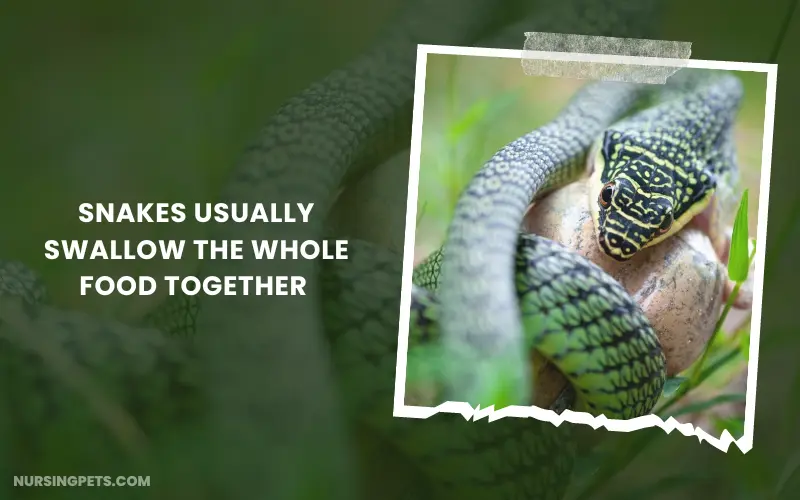
Some of the snake species that are able to eat full adult turtles are Kingsnakes and Anacondas. Snakes may also eat turtle eggs, which are easier to get in the wild.
What Type of Turtles Do Snakes Prey and Eat?
As previously mentioned, snakes that eat turtles usually target smaller turtle species, hatchlings, or juveniles. Larger snake species with specialized adaptations, such as flexible jaws and the ability to stretch their bodies, may be capable of consuming relatively larger turtle species.
The specific types of turtles that snakes eat can vary depending on the snake species, their size, and the available prey in their habitat. Generally, snakes tend to go for turtles that are appropriately sized for their own capabilities and dietary preferences.
Can Snakes Be Harmed by Eating Turtles?
Yes, snakes can be harmed by eating turtles. The turtle shell can be very difficult for the snake to digest and can damage the snake’s insides due to its sharp edges, or it could be too large to take in. Some snakes may also get injured while trying to swallow or kill the turtle.

Additionally, some reptiles, including turtles, may carry diseases that can affect humans and other animals.
Can snakes eat baby turtles?
Snakes do indeed find young turtles to be an easy meal. Little turtles move slowly, making them easy prey for predators like snakes.
On the other hand, not all snakes can consume turtles. A newborn turtle’s shell could be difficult for some snakes to digest, and many smaller kinds of snakes would not be able to digest one.
Are Snakes and Turtles Predators-Prey?
Generally speaking, snakes and turtles may live side by side in the same ecosystem without forming a predator-prey relationship. However, when there isn’t enough food, and the turtle is larger than the snake, or the snake is injured/helpless, then certain turtles will eat the snake.
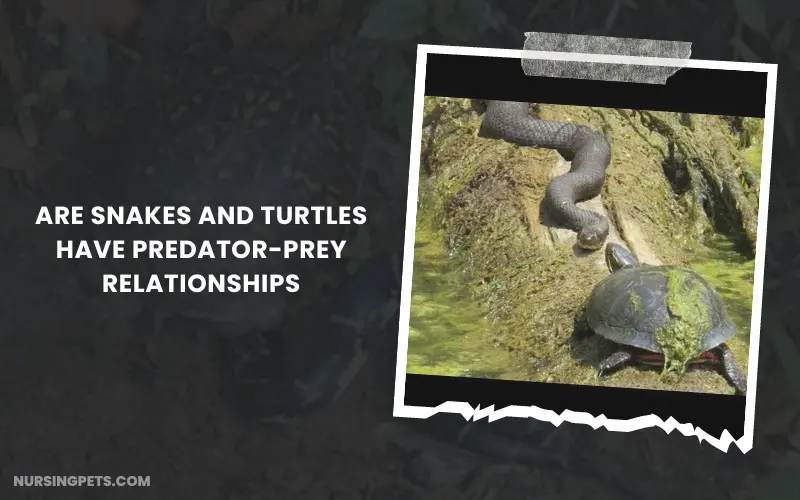
Conversely, several snake species may feed on smaller turtles, especially eggs or young turtles. The fact that turtles have strong shells that provide them some protection from predators makes this occurrence unusual as well.
It should be noted that snakes’ venom may be fatal to turtles, just as it can be to other creatures.
Can Snakes and Turtles Share the Same Habitat?
Certainly, it is possible for snakes and turtles to coexist, and such cohabitation is really rather frequent. Ectothermic animals like snakes and turtles depend on their surroundings to maintain a constant internal temperature.
As a consequence, they tend to congregate in the same places, such as beside bodies of water or in thickets of vegetation, that are ideal for their survival.

But not every snake and turtle pair get along. Water moccasins and several kinds of rattlesnakes are among the most aggressive snakes and may strike if they feel threatened.
In contrast, certain turtles have strong jaws and may administer a severe bite if provoked. This is especially true with snapping turtles.
Can You Feed a Snake to a Turtle? Or Vice Versa?
It is not a common or recommended practice to feed a snake to a turtle or vice versa. Turtles have different dietary preferences depending on their species and habitat and may not like or need snake meat. Snakes may also carry parasites or diseases that can harm turtles.
Therefore, feeding one species to another can lead to stress, injury, and even death for both animals.

Consequently, turtles and snakes have different dietary requirements and are not natural prey for each other in their respective ecosystems.
Moreover, feeding live animals to other animals raises ethical concerns. Also, in many cases, it’s illegal or prohibited by animal welfare laws.
Frequently Asked Questions
Do turtles in a pond eat snakes?
Turtles prefer fish, frogs, and invertebrates like snails and crayfish over snakes while foraging in a pond. However, several turtle species have been seen eating tiny snakes that are swimming in the water. This is particularly true of wounded or weak snakes.
It’s worth noting that not all turtle species have the strength to kill a snake and that the snake’s size and species also come into consideration whether or not a turtle will try to eat it.
Do turtles eat water snakes?
Although turtles and water snakes normally cohabit happily in their common environments, it is likely that some turtle species do prey on water snakes, especially if the snake is small enough to be captured and consumed.
Do turtles attract snakes?
Snakes may not always be drawn to a turtle’s presence. There is no evidence that turtles attract snakes or vice versa. However, certain species of turtles and snakes may share the same environment without interacting with one another.
Snakes tend to congregate in areas rich in prey, cover, and water. Although snakes may be drawn to certain areas, turtles may also get attracted to them.
Are turtles and snakes rivals for food and shelter?
Because of their shared diet, turtles and snakes may encounter competition for food in environments like marshes and ponds. However, they seldom interact with one another since they are specialized for particular tasks in their environment.
Final words
Your questions about who eats who have been answered. Even though turtles have been known to consume little snakes and snakes have been known to feed on young or small turtles, these interactions are very uncommon.
Instead, these two reptiles have quite distinct diets, with turtles focusing on water life and snakes hunting a wider variety of food.
The importance of turtles and snakes to their respective ecosystems can only be fully appreciated via an understanding of their complicated relationships with one another.
References:
- https://srelherp.uga.edu/snakes/agkpis.htm
- https://portal.ct.gov/DEEP/Wildlife/Fact-Sheets/Common-Snapping-Turtle
- https://animalia.bio/florida-softshell-turtle
- https://www.desertmuseum.org/books/nhsd_hognose_snake.php
- https://content.govdelivery.com/accounts/GADNR/bulletins/84d44d
- https://www.reconnectwithnature.org/news-events/the-buzz/what-difference-common-alligator-snapping-turtle/
- https://novascotia.ca/natr/wildlife/wns/wns7d.asp

